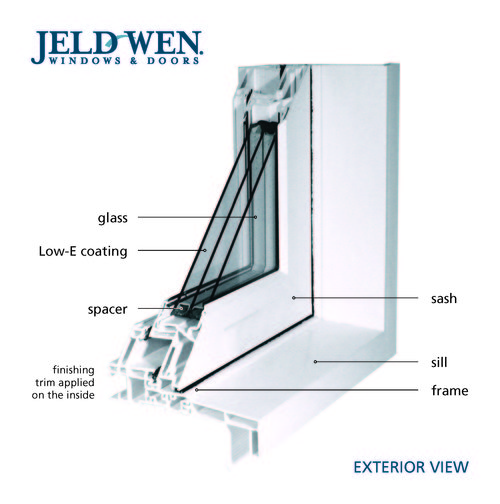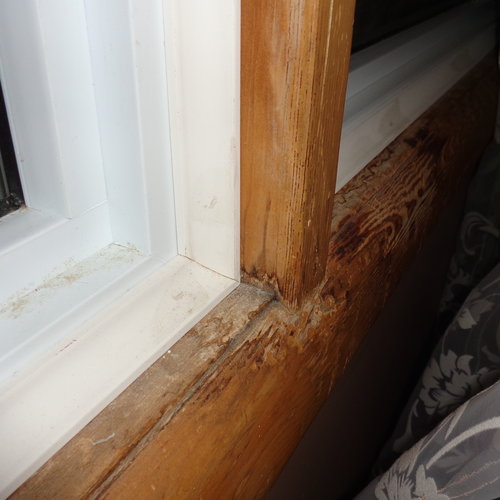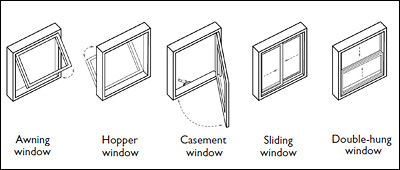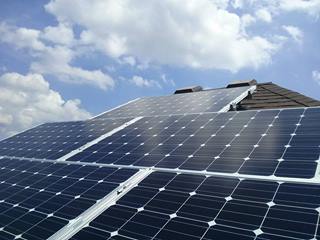“MUST KNOW” COMPONENTS OF A WINDOW
Like everything, windows have their own terminology and components you need to understand or at least be familiar with before you begin to investigate replacing your windows. When you talk to window contractors and sales people they will throw around words to describe window components and choices of features that will affect the function and importantly the price of your window and it can be confusing.
On top of knowing what features you need not all window contractors will produce a quote based on the same information. You will want to be sure you are comparing quotes based on the same products, service and installation features.
How is a window put together?
Understanding how a window is made will help you understand what makes a window energy efficient and meet your usage needs.
The window itself is composed of panes of glass with a spacer between them for separation, the sash which supports the glass panes, the frame which supports the sash and is used to fasten the window to the wall framing, and the exterior sill. See drawing supplied by Jeldwen Window and Doors.
Every window is finished with trim. There is the trim that goes around the window opening it cover the drywall edges and framing the finishing trim that matches your baseboards and other door trims in your home.
The “jamb extension” is a piece of 1x4” or 1x6” wood trim laid along the four sides of the window to extend over the rough opening. Basically it is an interior sill that hides all the wood framing around the window.
The“moulding” or “casing” is the trim around the window that covers the gap between the drywall and the jamb extension mentioned above. This is the trim that should match the baseboards and other door trim you are using in the room.
Both the jamb extension and the moulding can be installed by the window suppliers for an additional cost so make sure it is either included or excluded from all quotes when comparing.
When you purchase a window from a big box store the trim required to properly finish the window will not be included you will have to plan to purchase this in addition to the window.
What to look for when getting a window quote
You need to be able to compare quotes which include the same product and service.
Not all window installers and contractors will include all of the window components you will need when they are providing your requested quote. Be sure to compare your quotes looking at the same elements.
When requesting your quote you will need to clarify with your window installer:
- Type and size of the window.
- Include (or exclude) the interior trim. (window jamb extension and casing)
- Removing the entire existing window including the window sill
- Exterior finishing
Some window contractors will recommend leaving the old sills. It is best to remove all of the old window including the sills for energy efficiency and to inspect for any water damage to the existing wood frame structure like wood rot or other problems including carpenter ants and termites.
You don’t want to find these problems after the new window is installed. This photo gives you an idea of how much water damage can be hidden behind the old wood frame and plaster wall.
How many panes of glass (glazing)?
Pain in the (gl)ass? No not really, the choices are two or three but it impacts your budget.
In Canada a window requires double panes of glass (double glazed). In our climate triple glass panes is better for efficiency and reducing heat loss in winter and heat gain in the summer.
When purchasing windows with triple glass panes you will need to increase the size of the sash and/or change to a different frame material like fiberglass because of the increased thickness and weight. For large size windows and/or triple pane windows fibreglass is a better material choice that vinyl (PVC).With large windows vinyl will expand and contract more and does not have the integrity and strength of fiberglass. This can cause gaps around the window, problems with seals and future problems operating opening and closing mechanisms.
When it comes to windows always get the best you can afford.
Spacers
Not a term for the Astronauts volunteering for the one-way Mars trip
The spacer is the component that keeps a consistent air tight low conductivity seal between the two or three panes of glass of the window. It has an important job to be strong and air tight through any rain, wind, sun and temperature conditions for the life of the window. If the spacer does not stay air tight then during winter months you will see condensation between the panes of glass and the sash and panes will have to be replaced.
To be energy efficient the spacer also need to be made of a material that does not conduct heat or cold easily. If it is too conductive, during the cold winter here in Canada that cold temperature will be transmitted from the outside sash to the inside sash and you could see condensation on the sash.
This photo illustrates this issue during the winter of 2013-2014 in a house with low humidity, and no blinds on the window. It was just really cold and the cold was being transmitted through the sash. The condensation is not beading on the glass and running down on to the sash; it is beading on the sash because it is as cold as the glass.
Argon or Krypton Gas?
Not the next weapon against superman.
There is a space between the glass panes and that air space is filled with a gas to help increase the insulation value (decreasing U-factor) of the window. The gas needs to be denser than air. Argon is the standard gas used for this purpose. But you can also get krypton gas which has the advantage of being a slightly better insulator which is always good. Krypton is idea in triple pane windows because the window has less space and krypton is a denser gas. Krypton will cost more and it will be a special order window which may take longer to get delivered.
Window Coatings
Its Canada even our windows need coats.
Every window in Canada now comes with low-e coating because it increases the insulation value of the window and it helps heating the room in cold weather. Low emissivity (low-e) coating is a virtually invisible metallic coating applied to one or more panes of glass.
Originally e-coating was added just to reduce the U-factor (increase insulation value) of the glass component. Now, it is added to also allow little or a lot of solar radiation through your window into the room.
Speciality coatings can help if you have a south facing room that is usually too hot even in the winter. Ordering a spectrally selective low-e coating on your south facing windows can reduce the amount of heat transmitted through the window. According to the US Department of Energy these coatings can filter out 40 – 70% of the heat normally transmitted through the window but still allow the full amount of light transmission.
Window seals
What is the best window for air tightness?
Most people will replace their current windows with the same style as they are removing. Certainly ascetics will help guide your choice but you should also consider which window style has less air leakage. Common styles shown in figure below supplied by CMHC.
Casement style windows swing open outwards and swing closed inwards and have mechanisms that pull the window tight against a compression style weather stripping. This gives them the best air tight seal according to www.efficientwindows.org. Other popular style choices the slider and single/double hung windows use a brush style weather stripping which helps the window slide open but are not as air tight.
SUMMING IT ALL UP
Talk to your window installer and contractor with confidence
Knowing how your windows work will help you chose the most energy efficient and appropriate window for your home. Before you talk to your window supplier or contractor:
- Learn the basic components like sash, glazing, spacer, low-e, and argon gas.
- Make sure you are asking the contractors toquote the same style, features and components. Each manufacturer has their own standard features and some may include more features than others.
- Ask to have the contractor remove the entire old window down to wall framing. That is best for energy efficiency and ensuring there is no hidden water damage.
- Make sure all quotes include or exclude this removal so you are comparing apples to apples.
- Consider that the best window for air tightness is the casement style due to weatherstripping tightness and the lock tight mechanism.
For more information on windows checkout Home Front Inspections’ other blogs on Windows.
About the Author:
Brad Durant, RHI, P.Eng.
Civil Engineering Technologist for eight years then a Civil Engineer for 25 years and Owner of Home Front Professional home Inspections since 2003. Providing home inspections and Engineering Design Services in Guelph, Kitchener, Waterloo, Milton area. Brad is passionate about home technology, efficiency and sustainability. Brad is a Solar PV supporter and has a system installed on his own house.






